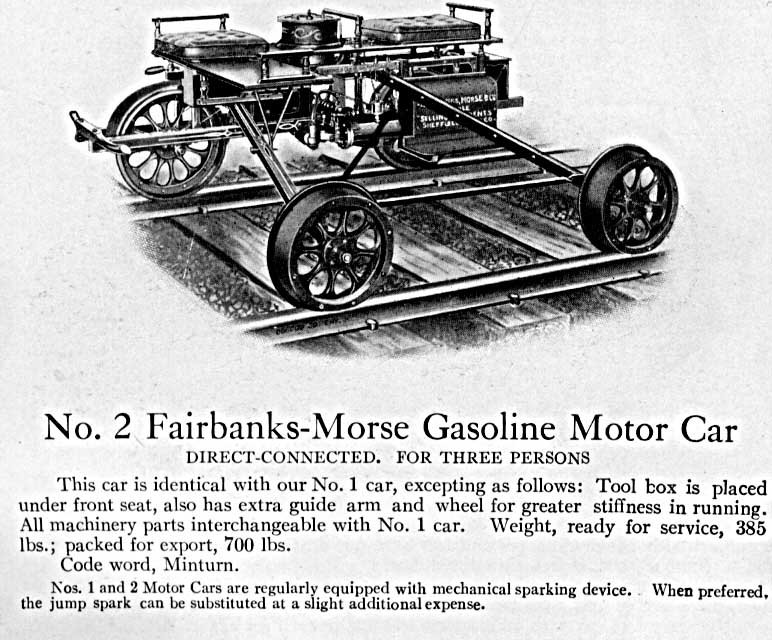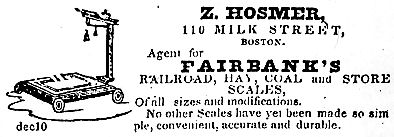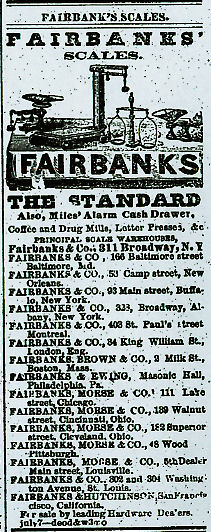Fairbanks, Morse & Company
In 1829, the brothers became involved in a hemp dressing business for which they built the machinery. Though this business was unsuccessful, if gave rise to another invention by Thaddeus: the platform scale. Prior to its invention, a load of hemp—or other material—had to be off-loaded so it could be suspended from the “steelyard,” a balance beam sort of device, to be weighed. This was both inefficient and had decided limitations. With the platform scale, the loaded wagon was simply rolled onto the scale and weighed; the known weight of the wagon was then subtracted, giving the weight of the load.
Erastus and Thaddeus received a patent on their “platform scale” dated 13 June 1831. [It was reissued March 1834 and again February 1837.] {391} They received further patents, for “weighing heavy bodies” dated 21 February 1832, and two more for “balance steelyards” dated 22 September 1832. {392} The brothers seemingly had no idea of marketing their useful device until a third brother, Joseph Fairbanks, joined the business. Needless to say, a device such as this caught on in an incredible way, and in 1833 the business was incorporated as E. & T. Fairbanks & Company. Likely due to the size of the scales, the remoteness of St. Johnsbury, and the fact that the platform was constructed on-site of locally-supplied timber, Fairbanks contracted with agents and mechanics who were given defined territories to sell, assemble and repair the scales. Fairbanks soon opened offices in New York and Boston. They also sold manufacturing rights to the British firm of H. Poole & Sons to supply Britain and the Continent. In 1846 they opened an office in China and in 1848 in Cuba. By 1860 they had offices in South America and throughout the Caribbean. And the firm had grown to more than 1,000 employees with an annual payroll of some $90,000. During the Civil War, production was turned to support of the war effort. But when it ended, production of scales resumed, rising rapidly to 4,000 per month. By 1868, Fairbanks had about 300 mechanics building scales, with annual production exceeding $500,000 in value [in excess of $6.3 million in today’s buying power]. A contemporary writer said, “About 150,000 scales have been made by the firm, including a number of weigh-lock scales, having a capacity of from 200 to 250 tons.” {404} Meanwhile . . .In 1867, the firm of L.H. Wheeler & Son was organized at Beloit, Wisconsin. Leonard Wheeler had designed a windmill that was both efficient and affordable and received Patent No. 68,674 on 10 September 1867. His original design had a four bladed wheel, but this was quickly replaced with the slatted wheel us old-timers remember as being typical of almost all farm windmills. Wheeler’s genius was to design and manufacture the windmill so it could be boxed for easy shipment, yet be easily assembled on-site. For reasons unknown, he chose the trade name Eclipse. Leonard Wheeler died in 1872, and 15 months later, on 13 May 1873, the business was incorporated as the Eclipse Wind Engine Company. By then, 2,000 Eclipse windmills had been manufactured, ranging in wheel size from 8˝' diameter to a whopping 30' diameter. And also . . .Back in 1853, Charles Hosmer Morse had joined his uncle Zelotus Hosmer in the Boston office of E. & T. Fairbanks & Company, marketing Fairbanks scales. He completed a three-year apprenticeship and eventually moved to Fairbanks’ New York office.
After the Civil War, Morse opened his own office to market Fairbanks scales at Cincinnati, Ohio, under the name of Fairbanks, Morse & Company. He also established a small manufacturing company to produce letter and waybill presses, warehouse trucks and other small items. And he added to his “catalog” coffee mills and those newfangled Remington typewriters. He also added sales offices in Cleveland, Pittsburgh and Indianapolis.
By 1875, the date of the newspaper advertisement to the right, Morse had Fairbanks, Morse & Co. offices in Chicago, Cincinnati, Cleveland, Pittsburgh and Louisville. In 1880, the Eclipse Wind Engine Company was reorganized, and Fairbanks, Morse & Co. became the exclusive agent for Eclipse windmills within its considerable territory. In addition, Morse became a stockholder in Eclipse. Eclipse continued to improve its products, including a patented friction clutch, and in 1885 it moved to larger facilities, still at Beloit, Wisconsin. It also began to expand its product line with windmill “accessories” such as wooden tanks, water towers and pumps. In 1889, prodded by competition, it added a steel windmill to its line. That same year (1889), Leonard H. Wheeler (Jr.) of Eclipse joined Edwin F. Williams in establishing the Williams Engine Works with Wheeler as President, to build steam engines. Morse thus had three products to market in addition to Fairbanks scales: Eclipse windmills and “accessories,” Eclipse friction clutches and Williams Steam Engines. Fairbanks, Morse & Company had an increasingly large catalog of farm and business, especially railway, supplies to sell. And on 27 June 1890, Morse became the controlling stockholder of Eclipse Wind Engine Company. Two years previously, Morse had pursued a similar strategy with regard to the Sheffield Velocipede Car Company of Three Rivers, Michigan. In 1888 [some say 1883, but that appears to be a typographical error], he had bought out the interests of Warren J. Willits, a substantial stockholder of that corporation. The Sheffield line included a number of different small work and utility cars and the noted “velocipede” rail car as well as other railway supplies. Fairbanks-Morse became general sales agency for all Sheffield products. During the 1890s, Fairbanks-Morse continued adding both a great many products to its “catalog” and a great many offices to its sales force. Wendel {130} says its 1901 Mining & Supply Catalog was a 700 page hardbound book. About 1906, Fairbanks began building gasoline powered railcars at its “Sheffield Works” in Three Rivers, Michigan. At this time FM&C was a “major producer of handcars and other railway supplies.” EHC says they “assembled and sold cars in the gasoline motor mechanical line, which were (and are) accepted and known as FAIRBANKS-MORSE gasoline cars.” The plant at Three Rivers, Mich., [Sheffield?] produced them during the “gas car period” of roughly 1906 to 1925. They were found in widely scattered places and were produced in “fairly large volume.” Car bodies were supplied by various car builders and assembly was done at Three Rivers. Contracts were in the name of F-M and finished units were shipped from the F-M plant [presumably at Three Rivers]. He illustrates (1) a small unit (#24 type) with Brill body and Taylor truck, and (2) a #19 type with body by “Sheffield Velocipede Car Company” of Three Rivers [which of course was the Sheffield Car Company by 1905 and became the “Sheffield Works” of F-M about 1918; but such was the impression made by that little three-wheeled vehicle that the name seemed to have a life of its own]. In 1944, the company began building diesel locomotives for mainline railroads. Locomotive production at the Beloit plant ended in 1963, and Fairbanks began specializing in rebuilding diesel locomotives. In 1964, Fairbanks became a wholly-owned subsidiary of Colt Industries, Inc. Cast of Characters —Thaddeus Fairbanks (1796-1886) was born at Brimsfield, Massachusetts. He came to St. Johnsbury, Vermont, at the age of 19 and assisted his father with a sawmill, a grist mill, and building carriages. Thaddeus had an aptitude for mechanics, and eight years later erected a foundry to manufacture several of his inventions: the first cast iron plow and an improved heating stove. In 1826, while engaged in the hemp dressing business with his brother Erastus, he invented the platform scale, on which he received a patent 21 June 1831. This was a vast improvement over the then-common method of weighing goods, which had to be unloaded and suspended from a “steelyard,” or balancing beam. Thaddeus spent much of the rest of his life improving this invention and broadening its application. It is estimated he obtained between 50 and 60 patents during his lifetime. Erastus Fairbanks (1792-1864) was also born at Brimsfield, Massachusetts. He came to St. Johnsbury, Vermont, in 1812 to study law in the offices of his uncle, Judge Ephraim Paddock. He gave up that study because of “weak eyes,” taught school briefly and then clerked in a store. He then became proprietor of his own store. Shortly after his brother Thaddeus established his iron foundry, Erastus joined him in the partnership of E. & T. Fairbanks. When the business was incorporated as E. & T. Fairbanks & Company, Erastus became its President, a position he held until his death. Erastus had interests in businesses other than E. & T. Fairbanks, including the Connecticut & Passumpsic River Railroad, of which he was also President from 1846 to 1854. He was elected to the Vermont legislature in 1836, and was elected Governor in 1852 and again in 1860. Joseph Paddock Fairbanks (1806-1855) was also born at Brimsfield, Massachusetts, but came to St. Johnsbury with his family in 1815. Like his older brother Erastus, he too read law with their uncle, Judge Ephraim Paddock. After practicing three years he decided he didn't care for it and became a storekeeper at Troy. He returned to St. Johnsbury to join E. & T. Fairbanks and become its sales representative. He was elected to the Vermont legislature in 1845, supporting the temperance movement and the abolition of slavery. Together with his brothers, he founded the St. Johnsbury Academy. Joseph was an avid reader, and opened the town’s first book store. He was also an avid writer, writing papers on agriculture, politics and religion. Charles Hosmer Morse (1833-1921) was born at St. Johnsbury, Vermont. He graduated from St. Johnsbury Academy [high school] in 1850. Shortly after graduation he joined his uncle, Zelotus Hosmer, in the Boston office of E. & T. Fairbanks, marketing platform scales. He was so successful that he was promoted to the New York office, and eventually to Chicago. He established the firm of Fairbanks, Morse & Company in 1866. In the 1880s, he became one of the earliest residents of Winter Park, Florida, and retired there permanently in 1915. Leonard H. Wheeler Sr. ( ?? -1872) was born at . He came to Wisconsin in the 1840s as a missionary to the Ojibway indians. For More Information —Pioneers in industry; the story of Fairbanks, Morse & Co., 1830-1945. Chicago, IL: Fairbanks, Morse & Co., 1945. Wendel, C.H. Fairbanks Morse 100 Years of Engine Technology. Original publisher unknown, 1982; Reprint, Lancaster, PA: Stemgas Publishing Co., 1993. Wendel, C.H. Power in the Past, Vol. 2; A History of Fairbanks, Morse and Co. Atkins, IA: Old Iron Book Co., 1982; Reprint, Lancaster, PA: Stemgas Publishing Co., 1987. Ryan, Francis X. “Crisis In a One-Industry Town: St. Johnsbury, Vermont, and Fairbanks, Morse & Co., 1815-1965,” Case studies in business history and economic life, 1st ser. Boston, MA: Business History and Economic Life Program, Northeastern University, 1976. Yale, Allen Rice. “Sleepers Awake! The Industrial Revolution Comes to Antebellum St. Johnsbury,” Vermont History 69 (Symposium Supplement): 116-121. Online (December 2004) at http://www.vermonthistory.org/journal/69/vt69_s10.pdf. Online — The Fairbanks Papers 1815-1889, Vermont Historical Society Library. Description of holdings online (December 2004) at http://www.vermonthistory.org/arccat/findaid/fairbank.htm. “Fairbanks Morse (Canada) Ltd.” University of Western Ontario website at http://www.lib.uwo.ca/business/ccc-fairbanks.htm. |


 Three years later, Morse became a
partner in the Chicago firm of Fairbanks, Greenleaf & Company.
Greenleaf died the following year, and Morse carried on the
business independently. However, in 1871, following the Great Chicago Fire, when Morse
re-opened the
fire-ravaged office, he did so under the name of Fairbanks, Morse & Company.
Three years later, Morse became a
partner in the Chicago firm of Fairbanks, Greenleaf & Company.
Greenleaf died the following year, and Morse carried on the
business independently. However, in 1871, following the Great Chicago Fire, when Morse
re-opened the
fire-ravaged office, he did so under the name of Fairbanks, Morse & Company.